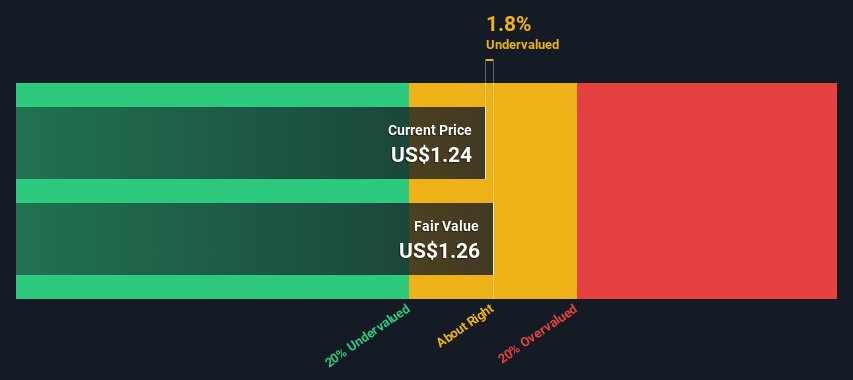- United States
- /
- Interactive Media and Services
- /
- NasdaqCM:CHR
A Look At The Fair Value Of Cheer Holding, Inc. (NASDAQ:CHR)
Key Insights
- Cheer Holding's estimated fair value is US$1.26 based on 2 Stage Free Cash Flow to Equity
- Current share price of US$1.24 suggests Cheer Holding is potentially trading close to its fair value
- Cheer Holding's peers seem to be trading at a higher discount to fair value based onthe industry average of 40%
How far off is Cheer Holding, Inc. (NASDAQ:CHR) from its intrinsic value? Using the most recent financial data, we'll take a look at whether the stock is fairly priced by taking the expected future cash flows and discounting them to today's value. The Discounted Cash Flow (DCF) model is the tool we will apply to do this. Believe it or not, it's not too difficult to follow, as you'll see from our example!
Remember though, that there are many ways to estimate a company's value, and a DCF is just one method. Anyone interested in learning a bit more about intrinsic value should have a read of the Simply Wall St analysis model.
We've discovered 4 warning signs about Cheer Holding. View them for free.What's The Estimated Valuation?
We are going to use a two-stage DCF model, which, as the name states, takes into account two stages of growth. The first stage is generally a higher growth period which levels off heading towards the terminal value, captured in the second 'steady growth' period. To begin with, we have to get estimates of the next ten years of cash flows. Seeing as no analyst estimates of free cash flow are available to us, we have extrapolate the previous free cash flow (FCF) from the company's last reported value. We assume companies with shrinking free cash flow will slow their rate of shrinkage, and that companies with growing free cash flow will see their growth rate slow, over this period. We do this to reflect that growth tends to slow more in the early years than it does in later years.
Generally we assume that a dollar today is more valuable than a dollar in the future, so we need to discount the sum of these future cash flows to arrive at a present value estimate:
10-year free cash flow (FCF) estimate
| 2025 | 2026 | 2027 | 2028 | 2029 | 2030 | 2031 | 2032 | 2033 | 2034 | |
| Levered FCF ($, Millions) | US$4.10m | US$2.40m | US$1.72m | US$1.40m | US$1.22m | US$1.13m | US$1.07m | US$1.05m | US$1.04m | US$1.04m |
| Growth Rate Estimate Source | Est @ -60.43% | Est @ -41.47% | Est @ -28.21% | Est @ -18.92% | Est @ -12.42% | Est @ -7.87% | Est @ -4.68% | Est @ -2.45% | Est @ -0.89% | Est @ 0.20% |
| Present Value ($, Millions) Discounted @ 11% | US$3.7 | US$1.9 | US$1.3 | US$0.9 | US$0.7 | US$0.6 | US$0.5 | US$0.5 | US$0.4 | US$0.4 |
("Est" = FCF growth rate estimated by Simply Wall St)
Present Value of 10-year Cash Flow (PVCF) = US$11m
The second stage is also known as Terminal Value, this is the business's cash flow after the first stage. For a number of reasons a very conservative growth rate is used that cannot exceed that of a country's GDP growth. In this case we have used the 5-year average of the 10-year government bond yield (2.8%) to estimate future growth. In the same way as with the 10-year 'growth' period, we discount future cash flows to today's value, using a cost of equity of 11%.
Terminal Value (TV)= FCF2034 × (1 + g) ÷ (r – g) = US$1.0m× (1 + 2.8%) ÷ (11%– 2.8%) = US$13m
Present Value of Terminal Value (PVTV)= TV / (1 + r)10= US$13m÷ ( 1 + 11%)10= US$4.5m
The total value, or equity value, is then the sum of the present value of the future cash flows, which in this case is US$15m. To get the intrinsic value per share, we divide this by the total number of shares outstanding. Compared to the current share price of US$1.2, the company appears about fair value at a 1.8% discount to where the stock price trades currently. Remember though, that this is just an approximate valuation, and like any complex formula - garbage in, garbage out.

The Assumptions
Now the most important inputs to a discounted cash flow are the discount rate, and of course, the actual cash flows. Part of investing is coming up with your own evaluation of a company's future performance, so try the calculation yourself and check your own assumptions. The DCF also does not consider the possible cyclicality of an industry, or a company's future capital requirements, so it does not give a full picture of a company's potential performance. Given that we are looking at Cheer Holding as potential shareholders, the cost of equity is used as the discount rate, rather than the cost of capital (or weighted average cost of capital, WACC) which accounts for debt. In this calculation we've used 11%, which is based on a levered beta of 1.585. Beta is a measure of a stock's volatility, compared to the market as a whole. We get our beta from the industry average beta of globally comparable companies, with an imposed limit between 0.8 and 2.0, which is a reasonable range for a stable business.
Check out our latest analysis for Cheer Holding
SWOT Analysis for Cheer Holding
- Debt is not viewed as a risk.
- Earnings declined over the past year.
- Shareholders have been diluted in the past year.
- Current share price is below our estimate of fair value.
- Lack of analyst coverage makes it difficult to determine CHR's earnings prospects.
- No apparent threats visible for CHR.
Looking Ahead:
Whilst important, the DCF calculation shouldn't be the only metric you look at when researching a company. The DCF model is not a perfect stock valuation tool. Rather it should be seen as a guide to "what assumptions need to be true for this stock to be under/overvalued?" For instance, if the terminal value growth rate is adjusted slightly, it can dramatically alter the overall result. For Cheer Holding, we've compiled three fundamental elements you should further examine:
- Risks: Be aware that Cheer Holding is showing 4 warning signs in our investment analysis , and 2 of those shouldn't be ignored...
- Other High Quality Alternatives: Do you like a good all-rounder? Explore our interactive list of high quality stocks to get an idea of what else is out there you may be missing!
- Other Environmentally-Friendly Companies: Concerned about the environment and think consumers will buy eco-friendly products more and more? Browse through our interactive list of companies that are thinking about a greener future to discover some stocks you may not have thought of!
PS. Simply Wall St updates its DCF calculation for every American stock every day, so if you want to find the intrinsic value of any other stock just search here.
New: AI Stock Screener & Alerts
Our new AI Stock Screener scans the market every day to uncover opportunities.
• Dividend Powerhouses (3%+ Yield)
• Undervalued Small Caps with Insider Buying
• High growth Tech and AI Companies
Or build your own from over 50 metrics.
Have feedback on this article? Concerned about the content? Get in touch with us directly. Alternatively, email editorial-team (at) simplywallst.com.
This article by Simply Wall St is general in nature. We provide commentary based on historical data and analyst forecasts only using an unbiased methodology and our articles are not intended to be financial advice. It does not constitute a recommendation to buy or sell any stock, and does not take account of your objectives, or your financial situation. We aim to bring you long-term focused analysis driven by fundamental data. Note that our analysis may not factor in the latest price-sensitive company announcements or qualitative material. Simply Wall St has no position in any stocks mentioned.
About NasdaqCM:CHR
Cheer Holding
Through its subsidiaries, provides advertisement and content production services in the People’s Republic of China.
Flawless balance sheet with moderate risk.
Similar Companies
Market Insights
Community Narratives





